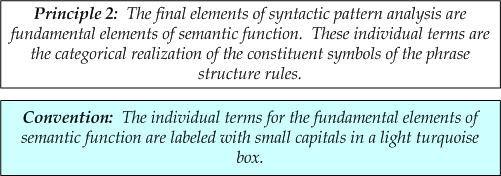
The analysis of grammatical phenomena involves first of all their observation from the point of view of some theory. The analyst examines the data systematically and assigns them to various classes according to their relationships to one another. One of the most important aspects of analysis is the process of breaking each complex object into simpler component parts. In this way analysis is opposed to synthesis. When we analyze each piece, we assign it to various subclasses according to the attributes it seems to manifest as it relates to other pieces. In the process of synthesis the classes and subclasses may be assigned to more general or abstract classes.
From a great deal of systematic grammatical analysis over the years certain principles and conventional practices have evolved. This section introduces eight principles which I have used to describe the various grammatical phenomena that I have observed.
1. The domain of study. The first principle tells the analyst how to represent the domain of study. Each domain is generally separated from others by means of language and culture. It generally deals with a single particular semantic field. Sometimes the domain has acquired a palpable reality by means of the models in our minds. In some cases science has quantified the various objects of the domain which then become tamed through technology. The objects of the domain fall into various patterns and arrangements that may be described in Backus-Naur form.

2. The semantic functions. The second principle tells the analyst how to represent semantic functions. Just like the pieces in a game of chess have a character and meaning, the objects of a domain relate to each other in various conventional ways. The various objects of analysis appear in patterns or arrangements serving their own particular functions, each having a purpose within the domain of study.

3. Intermediate elements. The third principle gives the analyst a way to symbolize the various intermediate arrangements and patterns of elements. Typically the domain is divided into separate sets of patterns and ordering of the functional elements. Each pattern is named in a relatively arbitrary way. Usually the analyst tries to minimize the number and variety of these patterns, but sometimes can make them more understandable by multiplying them.

4. Parts of speech. In the domain of language study the analyst represents the grammatical parts of speech as realizations of each semantic function. For each functional type there is a word or set of morphemes that can be characterized by some part of speech category. Sometimes these consist of more basic morphological parts, but sometimes they are not further analyzable by function. Every domain has a point in its analysis where morphological analysis impinges on the syntactic.

5. Morpheme types. The analyst represents the basic kinds of morphological units as parts of the word or part of speech. In English these categories of morpheme include the root or base word, a prefix, a suffix, and sometimes even an infix.

6. Semantic categories. When grouping semantic features or classes together, the analyst labels the result as a semantic category.

7. Distinctive semantic features. When modelling the semantic field, the various classes of elements are distinguished by named features. If there are only two values, the field is Boolean and sometimes a plus and minus before the name of the category will do. Otherwise the category is polytomous, i.e., it is characterized by many divisions (cuts). This kind of field is scalar, and most naturally mathematized using positive integers for index (subscripted) values.

8. Elemental units of analysis. The input to be analyzed by the linguist is often in the form of the written language. When a semantic field is being analyzed, the elements may be a mathematization or symbolization of the meanings that define the field.

